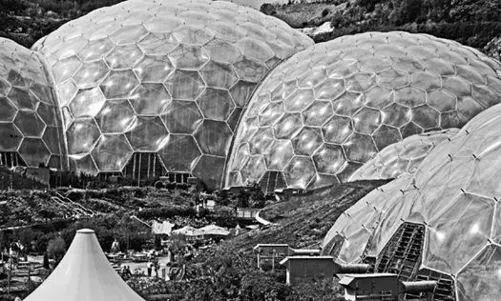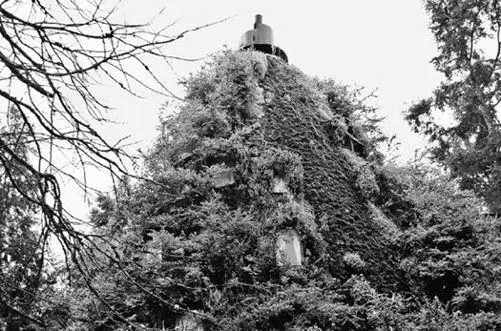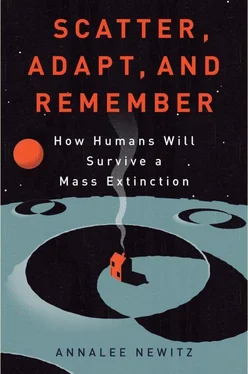
The Eden Project in Cornwall is an experiment with environmentally sustainable architecture; each dome contains its own ecosystem. In the future, cities might grow food or energy sources in such domes, or they might serve as water- and air-filtration devices for eco-buildings. (illustration credit ill.15)

In this example of eco-architecture, a hotel’s living walls are fed by a rooftop water source. The photograph was taken by Robinson Esparza, in the Huilo Huilo preservation area in Chile. (illustration credit ill.16)
Though that ad-hoc urban farmer’s market in Havana felt like a medieval oasis in the middle of a bustling, cosmopolitan city, it was actually a good demonstration of how people might grow and buy their food in the cities of tomorrow. They’ll do it by slowly converting cities into farms. At the time I was in Cuba, Raquel Pinderhughes, an urban planning professor at San Francisco State, wrote that there were over 8,000 farms in Havana, covering about 30 percent of the region’s available land. If you rode into the countryside on a bus that picked you up on Havana’s busy Malecón, a promenade along the seawall, you’d find that the high-density city quickly shaded into suburban residential areas peppered with farmland. Land planners sometimes call this system periurban agriculture. It transforms suburban consumer sprawl into a rich source of food production.
In the hot, dry valleys of Pomona, California, a nonprofit group called Uncommon Good has helped set up an urban farm where unemployed immigrants with farming experience grow organic food to sell in local markets. This Pomona farm, like many others, uses the “small-plot intensive farming” (SPIN) model, designed by urban farmers in Canada to maximize crop yields in areas of less than an acre. The idea behind SPIN is both agricultural and economic. Farmers vary their crops and use sustainable fertilizers to keep their small plots of soil fecund, and they sell by direct marketing in their local areas. This maximizes food production and minimizes the resources that the farmers need to transport that food to buyers. It’s easy to imagine many cities transformed by a SPIN model over the next 50 years, where people grow their own food to eat and sell to neighbors—who in turn sell different food, so that local diets can remain varied.
But will cities transform farming as much as urban farmers hope their methods will transform cities? In his book The Vertical Farm: Feeding the World in the 21st Century , Columbia University environmental-health professor Dickson Despommier argues that cities of the future might feed themselves by creating farms inside enormous, glass-walled skyscrapers where every floor is a solar-powered greenhouse. All water in these skyscraper farms would be recycled, and the structures themselves would be designed to be carbon neutral. While critics question whether it would be possible to heat, power, light, and tend skyscraper farms without wasting a lot of energy, Despommier’s thought experiment is a good one. We are going to need ways to produce enormous amounts of food in cities, often indoors, and trying to figure out how we’d do that in a skyscraper—or an underground cavern, for that matter—is a step in the right direction.
Our future buildings may be sprouting gardens on the outside, too. A popular way to transform cities in Germany is by building green roofs, which are basically special systems designed to convert rooftops into gardens. This isn’t just a matter of heaping some dirt up and throwing seeds on it. Green roofs are a complex system of layers designed to protect the roof, absorb water, and hold soil in place. Though they are unlikely to be useful for farming, some studies have shown that green roofs help cut energy costs by keeping buildings cooler in the summer months. They also reduce storm-water runoff, which is a huge issue in cities. Because most cities are covered in nonporous, nonabsorbent surfaces, all the grime, toxins, and trash in the city are washed out by rainwater during storms—and carried into nearby waterways, farms, and oceans. Having a roof that can absorb rainwater does a tremendous amount of good for the local environment and cuts costs related to water purification and treatment.
Bringing natural environments into cities isn’t just about feeding ourselves. It’s also about figuring out how to manage our energy consumption using tricks borrowed from nature. Growing shade plants on our roofs can help cut energy costs in summer, just as designing photosynthetic antennae like the ones mentioned in chapter 11 can help us power computers without burning coal. Natural ecosystems conserve energy remarkably well. As we learn to imitate that, our cities might become highly advanced technological entities that look strangely like the postapocalyptic jungle version of New York City in The World Without Us .
MIT’s environmental-policy professor Judith Layzer offered me a vivid picture of what life might be like in such a city. She believes that, ideally, most future human communities would be based in cities, leaving enormous stretches of land free for farms and wildlife. “We need to re-regionalize,” she told me. “A global economy doesn’t make sense environmentally. So your ecosystem would become your bioregion.” She described a world where communities would be organized around bioregions like the dense forests and rocky coasts of the mid-Atlantic states or the prairie grasslands of North America’s Great Basin. “Most of your food should come from your region,” she said, and farm labor would be done by people rather than machines. But, she asserted, “nobody would be working as hard as they are now” because life would have a much slower pace. “You’d have goats mowing lawns,” she said, her face quirking into a grin. “It would be less efficient in the contemporary sense. Long-distance travel would be more of a hassle. You’d bike everywhere.” In her ideal city, where food was local and energy carbon neutral, “you’d do everything with natural systems.” And the population of a city would never rise above a few million.
This kind of regionalism might be good for our ecosystems, but it probably couldn’t be as “natural” as Layzer imagines. Obviously, if people are depending on their bioregion for food, they’ll be more vulnerable to the vicissitudes of climate and seasonal drought. We’ll need cutting-edge technology to help these bioregional cities weather periods when the local ecosystem can’t support the population.
One possible way we’ll do this is by looking to outer space. At UC Santa Barbara, an international group of climate scientists, geographers, and geologists use satellite data to predict where drought will strike next. They call themselves the Climate Hazards Group, and their success at predicting drought is almost uncanny. Currently, they focus most of their efforts on Africa. Amy McNally, a geography researcher with the group, said she and her colleagues helped predict the summer 2011 drought in Somalia by correlating data drawn from satellite images of rainfall in the region with rain gauges on the ground. “They predicted the drought and the resulting famine a year in advance,” she said. Unfortunately, “even with that much forewarning, response didn’t make it in time for it to not get to a famine-level crisis.” But the group had gained more evidence about what signs indicated droughts to come.
Читать дальше








![Аннали Ньюиц - Автономность [litres]](/books/424681/annali-nyuic-avtonomnost-litres-thumb.webp)





